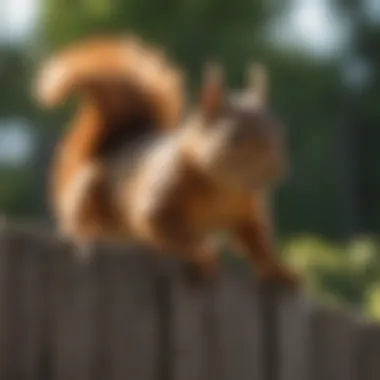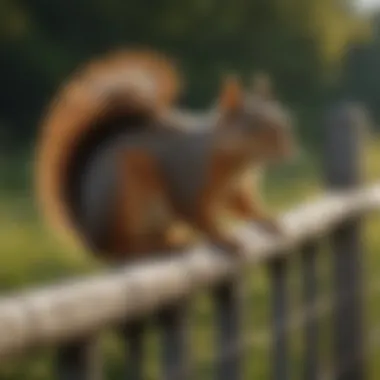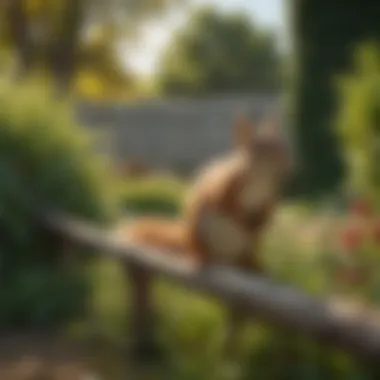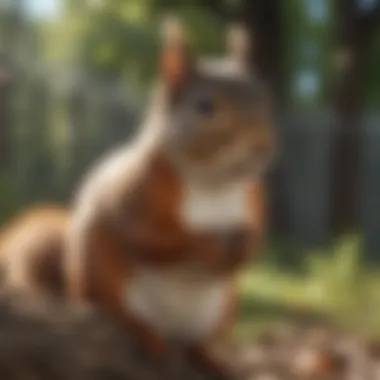Effective Strategies to Keep Squirrels Off Your Fence


Intro
Squirrels, those nimble little creatures that bound from tree to fence and back again, can indeed test one’s patience. Property owners, be it in a bustling city or the quiet countryside, often find themselves grappling with how to keep these furry intruders from tampering with their fences. Understanding why squirrels are drawn to your property and how they maneuver through their environment is essential in devising effective deterrents.
This article will offer a robust guide designed to equip you with the knowledge you need to outsmart these acrobatic rodents. By delving into their behaviors, we’ll uncover the strategies that can prevent them from making your fence their unwelcome playground. From basic concepts to innovative practices, let’s embark on this journey to protect your boundaries with purpose and precision.
Understanding Squirrel Behavior
Understanding the behaviors and habits of squirrels is essential when it comes to devising effective strategies for preventing them from accessing your fence. Squirrels can pose a significant nuisance, especially for farmers and rural homeowners who often invest considerable time and resources in maintaining their properties. To keep these pesky critters at bay, it's vital to tap into insights about their natural habits and tendencies.
Habitat Preferences of Squirrels
Squirrels prefer habitats that provide ample food and shelter. Generally, they thrive in areas abundant with trees, which serve both as a feeding ground and a nesting place. Oaks, maples, and pines are particularly attractive to them due to the abundance of nuts and seeds.
Here's a brief look at their habitat preferences:
- Tree Density: Squirrels are excellent climbers. They look for places densely populated with trees to facilitate their movement. A property surrounded by mature trees is particularly vulnerable.
- Urban Areas: Surprisingly, squirrels often adapt well to urban settings where they can find alternate food sources such as bird feeders and gardens. They can even establish nests in attics, further complicating control efforts.
By identifying these preferred environments, homeowners can take the first step in strategizing against squirrel incursions.
Feeding Habits and Seasonal Patterns
Like many animals, squirrels' feeding habits are closely tied to the seasons. They primarily forage for nuts, seeds, fruits, and grains. In the fall, for instance, their need to gather and store food intensifies as they prepare for the colder months. Here are some key points about their feeding habits:
- Food Storage: Squirrels are notorious for burying nuts and seeds to secure food for the winter. This habit can lead to uneven distribution of seeds in gardens and cause unexpected plant growth, further drawing squirrels to your yard.
- Changing Diets: During spring and summer, their diet expands to include mulch, green plants, and even insects. Being aware of what attracts squirrels to your property during certain times of year plays a crucial role in prevention strategies.
Climbing and Jumping Abilities
Squirrels possess impressive climbing and jumping skills, which enable them to easily scale fences, trees, and buildings. They can leap distances up to ten times their body length, allowing them to navigate obstacles with ease. This agility makes physical barriers particularly challenging without careful planning. A few notable features of their abilities include:
- Vertical Scaling: Adult squirrels are agile climbers, so fences less than six feet high may not provide adequate deterrents. Additionally, their ability to jump means they can reach a fence from trees or adjacent structures.
- Adaptability: These animals are quick learners. If they frequently find a way to breach your defenses, they’ll come back for more. Therefore, laying down a singular method may not guarantee long-term success.
Understanding these aspects of squirrel behavior equips property owners to take informed steps to protect their fences. By recognizing their preferences, feeding habits, and remarkable physical abilities, one can tailor effective strategies to keep squirrels at bay. This foundational knowledge becomes instrumental in devising a multi-faceted approach to deter these creatures while protecting the integrity of your yard.
Identifying Problem Areas on Your Fence
Identifying problem areas on your fence is a crucial step for any property owner who wants to prevent squirrels from munching through their territory. Squirrels, lively little creatures that they are, can be quite the nuisance. They don't just invade; they cause damage and can create habitation problems by chewing on wooden fences or even electrical wiring. By pinpointing these vulnerabilities, you not only protect your property but also save yourself a fair share of maintenance costs down the line.
Doing a thorough inspection helps in understanding where squirrels are most likely to get in. Think of it as an investment in peace of mind. By recognizing common entry points and signs of squirrel activity early on, you can implement strategies before a small problem blows up into a major headache.
Common Entry Points for Squirrels
Squirrels are acrobatic and resourceful. You might be surprised at how they find their way to your fence. Here are a few common entry points you should watch for:
- Holes and Gaps: Look for gaps or small holes in and around the fence. Squirrels often make their way through spaces that may seem insignificant to us, like openings where the wood has rotted or where two fence panels meet.
- Tree Branches: If there's a tree or bush nearby, those branches can act as a trampoline for squirrels. They launch themselves from these vantage points onto your fence.
- Ground Level Access: Squirrels like to burrow, so any low area near the base of your fence must be scrutinized. They can dig and sneak under if the fence doesn’t extend underground enough.
- Climbing Frames: If you have a trellis or a lattice fence design, squirrels skillfully navigate these surfaces. Look for places where they might leverage their climbing ability.
By identifying these points, you arm yourself with knowledge. This is key in deciding which preventive measures to take.
Signs of Squirrel Activity


Spotting signs of squirrel activity will give you the upper hand in your battle against these small invaders. Here are some indicators that squirrels are making themselves comfortable:
- Chewed Wood: If you see fresh chew marks or wood shavings around your fence, it’s a telltale sign that they’ve found a way in. Fresh markings show they are currently in the area.
- Droppings: Squirrel droppings are relatively small and can be found scattered around their entry points. Recognizing them is imperative as it tells you how active the area is.
- Nests: Look for nests in nearby trees or shrubbery. These nests can sometimes be spotted high in branches, made of twigs, leaves, and other debris. If squirrels are nesting close to your fence, they are lying in wait to explore your property.
- Chattering Sounds: Listen out for chattering or rustling noises, particularly at dawn or dusk. These sounds can indicate that squirrels are active in the vicinity of your fence.
Regularly observing these signs will ensure you stay ahead of the curve. Identifying both problem areas and signs of activity paves the way for implementing successful deterrent methods. The sooner you can address the issue, the less likely you'll encounter bigger problems down the road.
Altogether, staying vigilant about the state of your fence and recognizing squirrel behaviors is among the best defenses in keeping these spirited little creatures at bay.
Physical Barriers to Keep Squirrels Away
When it comes to preventing squirrels from invading your space, physical barriers play a critical role. These structures not only create a tangible wall that squirrels cannot cross but also provide a sense of security for your property. Installing effective barriers can significantly reduce the chances of a squirrel making a meal out of your carefully tended flowers or stealing precious garden vegetables. Plus, managing these critters is not just about keeping them off your fence, but also protecting the entire ecosystem of your yard or farm.
Let’s explore three practical and effective solutions to erect these protective blockades.
Wire Mesh Solutions
Using wire mesh is one of the simplest and most reliable strategies to keep squirrels at bay. It's like putting up a sturdy bouncer at the entrance. Wire mesh, preferably galvanized or coated to prevent rust, can be placed directly along the fence or attached to the lower sections. The holes in the mesh need to be small enough—ideally less than an inch—to prevent squirrels from squeezing through, as these rodents can slip through surprisingly tight spaces.
Benefits of Wire Mesh:
- Durability: It’s weather-resistant and maintains its integrity over time.
- Visibility: Unlike solid barriers, it allows light and airflow, keeping your garden vibrant.
- Cost-Effective: Wire mesh can be purchased in bulk, making it budget-friendly.
However, installation requires some consideration. It's essential to bury a few inches of the mesh underground to deter digging. Squirrels can be relentless when they set their sights on a garden full of delights.
Installing a Slanted Top on Fences
Adding a slanted top to your existing fence can turn the odds in your favor. Squirrels are known for their incredible climbing skills, and a vertical fence alone may offer inadequate deterrence. A slanted top, however, makes their acrobatics a whole lot tougher. This design can be achieved using a few angled boards extending outward from the top of the fence.
Considerations for Slanted Tops:
- Angle of Slant: A gentle angle is often most effective; too steep may simply invite other animals to try their luck.
- Height Matters: Ensure the fence is high enough to complement the slant; a short fence calls for a steeper slope to be effective.
It's also worth noting, this method may improve the aesthetic appeal of your fence, providing a unique and modern look while providing functional benefits.
Using Squirrel Guards
Squirrel guards are specialized deterrents designed to specifically challenge the abilities of these furry critters. Often seen as a last line of defense, these guards can be attached to existing fence posts or entry points, effectively foiling even the most determined squirrel’s plans. They typically feature slick surfaces that make climbing nearly impossible—think of it like a slippery slide for squirrels.
Benefits of Squirrel Guards:
- Easy to Install: Many products come pre-packaged and require minimal tools and effort to set up.
- Multiple Designs: You’ll find many options, including cones or decorative shields that can blend well with your fence while functioning effectively.
It's important to check the guards frequently, ensuring they remain secure and effective, as the elements can sometimes wear them down.
"Physical barriers provide the first line of deterrence, enabling property owners to combat squirrel invasions effectively. "
Repellent Strategies for Evasive Measures
Repellent strategies serve as a crucial component in the overall effort to deter squirrels from accessing your fence. These measures can be categorized into natural deterrents and commercial repellent products. Effectively utilizing these approaches can not only keep your property squirrel-free but also promote a balanced relationship with the surrounding ecosystem. Considering both the effectiveness and potential ecological impacts of these measures is essential for responsible wildlife management.
Natural Deterrents


Natural deterrents are substances or methods drawn from nature that can repel squirrels without harming them or other wildlife. These solutions are generally favored by property owners who seek a gentler approach to squirrel management. While there are various options to explore, a few stand out in effectiveness:
- Pepper Sprays: The pungent aroma of hot peppers can surprise squirrels and keep them at bay. Spraying a mix of pepper powder and water around your fence may create an unwelcoming zone for them. The spice burns their noses, urging them to steer clear.
- Essential Oils: Certain essential oils, such as peppermint and cinnamon, can be particularly effective. Mixing a few drops with water in a spray bottle and applying it along fence lines can create a strong scent that squirrels tend to avoid.
- Predator Urine: Quite unconventional to some, using fox or coyote urine can introduce a natural predator scent in the area. The instinctive fear of these predators can deter squirrels from venturing too close to your fence.
It’s crucial to regularly reapply these solutions, especially after rain, to maintain their effectiveness.
Commercial Repellent Products
For those who prefer ready-made solutions, a range of commercial repellent products are available in the market. These products often blend both natural and synthetic ingredients specifically designed to ward off squirrels. While shopping for such products, consider the following:
- Sprays: Many companies offer sprays that incorporate herbal extracts or strong-smelling ingredients. These sprays are user-friendly and just require a quick application along fence lines.
- Granules: Some repellents come in granular form, made to be scattered around the base of the fence. The scent often deters squirrels against coming close, ensuring they think twice before approaching.
- Ultrasonic Devices: These tools emit high-frequency sounds that are unpleasant for squirrels and other rodents but can’t be heard by humans. Setting these devices can act as a long-lasting deterrent to keep squirrels on the run.
When using commercial products, it’s vital to read and adhere to the instructions provided. Many products will include details about application frequency, dosage, and safety considerations. Regular observation of your property can also help gauge the effectiveness of these products, making adjustments as necessary.
"Utilizing a combination of natural and commercial repellents offers a balanced strategy that can yield favorable results in squirrel deterrence."
Environmental Considerations
When addressing the challenge of keeping squirrels from accessing your fence, it’s crucial to look beyond mere physical barriers and repellents. The environmental considerations surrounding your deterrent strategies can significantly influence the results you achieve. Understanding the impact of your methods on the ecosystem can help ensure you promote a balance between protecting your property and fostering a healthy habitat for local wildlife. This section dives into the implications of chemical repellents and the importance of biodiversity, two key elements that matter for any proactive property owner.
Impact of Chemical Repellents on Other Wildlife
While it may be tempting to reach for the strongest chemical repellents on the market to fend off squirrels, property owners must ponder how these substances ripple through the ecosystem. Many chemical deterrents are not selective; they can affect a variety of non-target animals. This can lead to unintended consequences—when you block squirrels, you might also deter beneficial species, such as birds and pollinators.
Additionally, chemical runoff from these products can contaminate nearby soil and water sources. The effects could be devastating, potentially harming local flora and fauna in ways that take years to recover. For example, garden habitats that once flourished might struggle to maintain a balance if chemical repellents seep into the ground.
Here are a few things to keep in mind:
- Research before you spray: Investigate the products you consider using and opt for those that are less harmful to other wildlife.
- Apply with caution: When using chemical repellents, make sure to follow guidelines on application to minimize impact on the surrounding environment.
- Monitor wildlife: Pay attention to changes in animal presence in your yard after applying repellents.
"Protecting your space doesn't have to mean compromising the entire ecosystem. "
Promoting Biodiversity While Deterring Squirrels
A balanced ecosystem is a thriving one. Promoting biodiversity while trying to shield your fence from squirrels can feel like a tricky task, but it is achievable with mindful planning and strategy. Creating an environment that nurtures various species not only enhances your property but also acts as a natural deterrent for squirrels.
Here are some viable methods to consider:
- Native plant selection: Incorporate native plants into your garden. These plants are naturally suited to local wildlife, often deterring squirrels through natural barriers or scent.
- Wildlife shelters: Adding birdhouses or insect hotels provides habitat for birds and beneficial insects, which can act as natural predators to pests, including squirrels.
- Strategic plant placement: Position thorny plants or shrubs near your fence. Just the presence of these plants can make that area less inviting for squirrels, nudging them to reconsider their clutch.
By fostering a rich biodiversity, you not only deter unwanted visitors but also invest in the health of your ecosystem, cultivating an environment that benefits everyone. Remember, every little effort counts when it comes to maintaining ecological balance.
Effective Maintenance Practices
Maintaining a fence that keeps squirrels at bay goes beyond merely installing barriers; it is a continuous commitment that ensures the effectiveness of your preventive strategies. Regular maintenance practices are crucial, as they help identify weaknesses in your defenses before squirrels exploit them. This not only protects your property but also preserves the integrity of your fence over time. Putting in place a routine inspection and repair schedule engenders peace of mind, ultimately leading to a more harmonious coexistence with your environment.
Regular Inspections and Repairs
Conducting regular inspections of your fence is imperative. It should be no surprise that structural integrity weakens over time due to weather effects, wear and tear, and even pest damage. Here’s how to approach this effectively:


- Frequency of Inspections: Depending on the material of your fence and surrounding environment, inspect your fence at least quarterly. Areas prone to moisture or soil erosion may require more attention.
- Look for Signs of Damage: During inspections, take note of any loose or warped boards, damaged wire mesh, or signs of rodent activity such as droppings. A squirrel scarcely needs an opening larger than a quarter to gain access.
- Timely Repairs: Don’t let small issues slide. A minor repair today can save extensive labor and costs tomorrow. Mend any weak points immediately to maintain the effectiveness of your prevention strategies.
By staying vigilant and proactive, you enforce a barrier not only against squirrels but also against the usual wear and tear that comes with time.
Routine Cleaning of Fencing Areas
Another essential component of maintenance is routine cleaning of fencing areas. Keeping the area surrounding your fence tidy does more than just enhance aesthetics; it directly impacts your success in keeping squirrels away. Here are some points to keep in mind:
- Debris Removal: Regularly clear away leaves, branches, or any other organic material that accumulates near your fence. This organic material can create shelters for squirrels, making them more likely to linger.
- Food Sources: If you have any nearby fruit trees or gardens, be aware that fallen fruits or vegetable scraps can attract squirrels. Maintaining a clean environment reduces food availability, thereby discouraging their presence.
- Chemical Buildups: If you are using any chemical repellents or cleaners, be careful to remove residues that may accumulate over time. This can prevent unintended odors that some wildlife may be attracted to.
"Keeping your fence area clean is like keeping a tidy kitchen; you wouldn't want to work with messy counters just as you shouldn't have messy surroundings around your fence."
By integrating these effective maintenance practices into your routine, you create a robust environment that hinders squirrel access. The time and effort invested in inspections and cleanings translate into better results and fewer surprises.
A well-maintained fence serves not only as a barrier to squirrels but as a testament to your commitment to effective property management.
Community Approaches to Squirrel Management
Tackling the problem of squirrels isn’t just a solitary endeavor for property owners. When neighbors band together, they can develop effective solutions, creating a united front against these pesky critters. Community approaches to squirrel management are important because they unify efforts, increase resource availability, and foster communication about best practices among local residents. By pooling knowledge and strategies, a neighborhood can become more resilient against squirrel invasions, benefiting both individuals and the community as a whole.
Collaborative Strategies Among Neighbors
A neighborly collaboration can take many forms, from informal chats over the fence to organized neighborhood meetings. Here are some strategies to consider:
- Forming a Neighborhood Watch Group: Just as residents come together to watch over their homes, they can do the same for their yards. Regular meetings can discuss squirrel sightings, effective deterrents, and share personal success stories.
- Sharing Resources: If one household invests in a high-quality repellent product or an innovative physical barrier like squirrel guards, others might benefit from their experiences. By pooling resources, costs can be reduced, allowing more households to implement protective measures effectively.
- Organizing Community Clean-up Events: Squirrels are often drawn to food sources. Organizing park clean-ups or garden tidy-ups can eliminate potential feeding ground, such as fallen fruits or uneaten pet food left outside.
- Collective Implementation of Eco-Friendly Practices: Neighbors can engage in discussions about using environmentally friendly strategies, ensuring that pest control methods are not harmful to other wildlife or pets.
These strategies spotlight how collaboration can enhance individual efforts while also knitting tighter community bonds.
Promoting Awareness of Squirrel Behavior
Understanding how squirrels operate significantly equips a community to manage them better. Knowing their habits allows individuals to take informed action together.
- Educational Workshops: Local community centers could host workshops focused on educating residents about squirrel behavior—what attracts them, their nesting habits, and the seasons when they are most industrious. This knowledge empowers individuals to act before squirrels can become a nuisance.
- Sharing Information: Neighbors can set up an informal WhatsApp or Facebook group where they can post about activities like squirrel sightings or attacks on gardens. This real-time sharing can help create awareness and promote quicker responses.
- Encouraging Observational Practices: Local schools could incorporate squirrel behavior into learning—such as sketching or journaling about local wildlife. Engaging younger generations helps ensure that future residents are better informed.
"The best way to combat a squirrel problem is by taking proactive measures as a community. With collective awareness, we can prevent an isolated issue from becoming a widespread nuisance."
When communities come together to understand and manage their squirrel populations collaboratively, they can experience not only a reduction in conflicts with these animals but also stronger ties among residents.
Epilogue and Best Practices
Wrapping things up, it’s clear that preventing squirrels from accessing your fence requires a multi-faceted approach. The significance of this topic doesn't just lie in keeping these furry critters at bay; it goes deeper into maintaining the integrity of your property and enhancing ecological balance.
When you take measures to create an unfriendly barrier for squirrels, you’re also considering the broader implications on other wildlife and plants in your garden.
Summarizing Effective Strategies
To effectively keep squirrels from climbing your fence or nesting nearby, consider these key strategies:
- Physical Barriers: Use wire mesh or sturdy fences designed with slanted tops to prevent climbing. A physical obstacle is often the simplest solution to keep them away.
- Repellent Options: While natural deterrents like cayenne pepper can work, don’t overlook commercial products that are specifically designed for this purpose. The right repellent can save a lot of headaches.
- Regular Maintenance: A well-maintained fence speaks volumes. Regular inspections and repairs ensure that any vulnerabilities are quickly addressed, making it difficult for squirrels to find access points.
- Community Collaboration: Don’t face the challenge alone. Discuss strategies with neighbors to create a united front against these squirrels, making it harder for them to slip through unnoticed.
Each of these tactics builds upon the last, creating a comprehensive shield against squirrel incursions. While it might require an initial investment of time and resources, the long-term gains in peace of mind and property protection are well worth it.
Encouraging Responsible Wildlife Management
Now, let’s talk about the golden rule of wildlife management: balance. Encouraging responsible practices means understanding that squirrels are part of an ecosystem. Rather than viewing them solely as pests, consider fostering an environment where they can exist without causing havoc. Here’s how:
- Alternative Food Sources: Instead of letting your bird feeders become squirrel buffets, try using squirrel-proof feeders or place them high enough to deter squirrels.
- Habitat Modification: Trim branches that hang over your fence. This limits their access routes and discourages them from using your structure as a launching pad.
- Education and Awareness: Teach your community about the impact of wildlife management. By understanding squirrels’ behavior and habitats, you can collectively make informed decisions that'll benefit your landscape without unnecessary harm.
"Balancing your garden's health with wildlife needs fosters a richer ecosystem."















